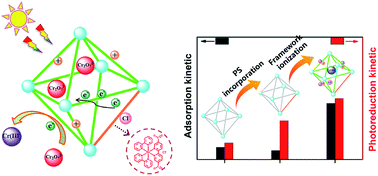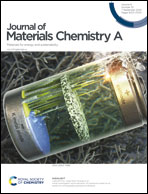Boosting the photoreduction activity of Cr(vi) in metal–organic frameworks by photosensitiser incorporation and framework ionization†
Abstract
It is mandatory to decontaminate Cr(VI) species from water streams due to their high toxicity. The photoreduction of hazardous Cr(VI) to nontoxic Cr(III) is a very promising approach to control Cr(VI) pollution. Although some MOFs and their composites have been employed as photocatalysts to reduce toxic Cr(VI), their catalytic activities are always limited by inefficient visible light absorption and inferior Cr(VI) adsorption performances. Herein, cationic Ru-UiO-dmbpy(1) that is decorated with a high density of cationic charges and also embedded with catalytically competent and visible light harvesting moieties (i.e. Ru(bpy)3) was successfully synthesized by a sequential mix-and-match and ionization process. The presence of Ru(bpy)3 moieties makes Ru-UiO-dmbpy(1) an excellent visible-light harvester, extending the absorption edge from 420 nm for pristine UiO-bpy to about 780 nm for Ru-UiO-bpy/Ru-UiO-dmbpy(1). Driven by ion exchange, Ru-UiO-dmbpy(1) shows a large adsorption rate constant (k2) of 1.33 × 10−2 g mg−1 min−1 in the adsorption of Cr2O72−, which is 8.26 times that of pristine UiO-bpy and 6.27 times that of the non-ionization counterpart Ru-UiO-bpy(1) under the same adsorption conditions. The equilibrium Cr2O72− uptake capacity of Ru-UiO-dmbpy(1) reaches 101.8 mg g−1, which is about 1.98 and 1.81 times that of UiO-bpy and Ru-UiO-bpy(1), respectively. With an efficient visible light absorption ability and superior Cr(VI) adsorption performance, Ru-UiO-dmbpy(1) shows a reaction rate constant (k1) of 0.011 min−1 in the photoreduction of Cr(VI) without any sacrificial agents under visible light illumination, which is much larger than those of pristine UiO-bpy (0.003 min−1) and its non-ionization counterpart Ru-UiO-bpy(1) (0.007 min−1) under the same conditions. The result unambiguously demonstrates that the Cr(VI) photoreduction activity could be largely enhanced by photosensitiser introduction and framework ionization. To further evaluate the catalytic performance of Ru-UiO-dmbpy(1), Cr(VI) reduction was also investigated in the presence of various sacrificial agents. Remarkably, a high Cr(VI) photoreduction rate of 6.4 mgCr(VI) gcatalyst−1 min−1 was obtained when benzyl alcohol was used as a sacrificial agent, which is a record value among those reported for MOF-based photocatalysts.



 Please wait while we load your content...
Please wait while we load your content...